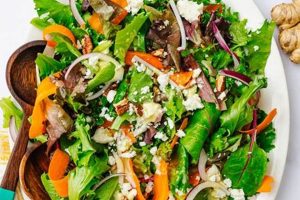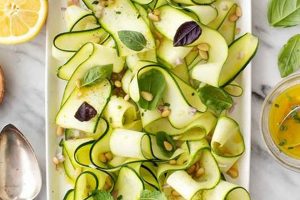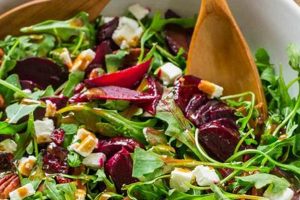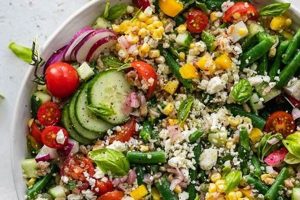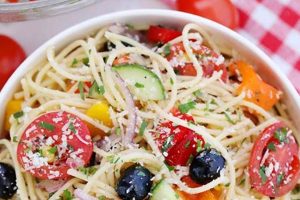A Chesapeake classic, this dish typically features a medley of fresh, locally sourced seafood such as crab meat, shrimp, and scallops, often combined with celery, onion, and a simple, tangy mayonnaise-based dressing. Variations might include hard-boiled eggs, mustard, Old Bay seasoning, or other regional spices. An example would be a combination of jumbo lump crab meat, steamed shrimp, bay scallops, finely diced celery and red onion, and a dressing of mayonnaise, apple cider vinegar, Dijon mustard, and Old Bay.
This style of salad reflects Maryland’s rich maritime history and its abundant seafood resources. It represents a culinary tradition that emphasizes fresh, high-quality ingredients and straightforward preparation, allowing the natural flavors of the seafood to shine. Often served as a light lunch or appetizer, this type of salad offers a refreshing and nutritious meal, embodying the flavors of the Chesapeake Bay region.
The following sections will explore specific ingredient selections, preparation techniques, variations, and serving suggestions for creating an authentic Maryland seafood salad experience.
Tips for an Authentic Maryland Seafood Salad
Achieving optimal flavor and texture requires attention to detail throughout the preparation process. The following tips offer guidance for creating a truly exceptional Maryland seafood salad.
Tip 1: Source Fresh, High-Quality Seafood: The foundation of any successful seafood salad lies in the quality of its ingredients. Whenever possible, utilize fresh, locally sourced seafood. Look for vibrant color, firm texture, and a clean, oceanic aroma.
Tip 2: Gentle Handling is Key: Seafood is delicate. Avoid overmixing or handling the ingredients roughly, as this can result in a mushy texture. Gently fold the ingredients together to maintain the integrity of the seafood.
Tip 3: Balance the Dressing: The dressing should complement, not overpower, the seafood. A classic combination includes mayonnaise, vinegar, and spices, offering a tangy counterpoint to the sweetness of the seafood. Adjust seasonings cautiously, allowing the natural flavors to take center stage.
Tip 4: Proper Chilling Enhances Flavor: Chilling the salad for at least 30 minutes before serving allows the flavors to meld and develop fully. This also enhances the refreshing qualities of the dish.
Tip 5: Consider Textural Variety: Incorporating a variety of textures elevates the dining experience. A combination of lump crab meat, chopped shrimp, and thinly sliced scallops creates a pleasing interplay of textures.
Tip 6: Old Bay Seasoning: A staple in Maryland cuisine, Old Bay Seasoning contributes a distinctive blend of herbs and spices. While not strictly traditional in all versions, it adds a recognizable regional flavor profile.
Tip 7: Presentation Matters: Consider serving the salad on a bed of crisp lettuce, garnished with fresh herbs such as parsley or dill. Lemon wedges provide a bright, acidic counterpoint.
By adhering to these guidelines, one can craft a Maryland seafood salad that showcases the region’s culinary heritage and celebrates the bounty of the Chesapeake Bay.
The following section will provide a sample recipe incorporating these tips for a truly authentic Maryland seafood salad experience.
1. Fresh, Local Seafood
Fresh, local seafood is integral to an authentic Maryland seafood salad. The Chesapeake Bay’s bounty historically provided ready access to a variety of seafood, shaping the character of this regional dish. Utilizing fresh catches minimizes the time between harvest and consumption, maximizing flavor and texture. The delicate sweetness of freshly caught crab, the firm texture of just-harvested shrimp, and the subtle brininess of day-boat scallops contribute distinct nuances impossible to replicate with frozen or imported alternatives. For instance, a salad featuring freshly caught blue crab from the Chesapeake Bay will offer a sweeter, more delicate flavor compared to one made with imported crab. This emphasis on fresh, local ingredients reflects a deep respect for the region’s maritime heritage and its culinary traditions.
Prioritizing local sourcing also supports sustainable fishing practices and strengthens the connection between consumers and the Chesapeake Bay ecosystem. Choosing seafood from local watermen ensures a reduced carbon footprint compared to ingredients shipped long distances. This commitment to local sourcing fosters environmental stewardship while preserving a vital part of Maryland’s cultural identity. Furthermore, the availability of specific seafood varieties fluctuates seasonally, influencing traditional preparations. For example, the abundance of blue crab during summer months makes it a prominent ingredient in seafood salads during this time, showcasing seasonality’s influence on the dish.
Understanding the importance of fresh, local seafood in a Maryland seafood salad deepens appreciation for the dish’s cultural and ecological significance. This connection underscores the value of sustainable practices and emphasizes the role of regional ingredients in shaping culinary traditions. Supporting local watermen ensures the continuation of these traditions while promoting responsible resource management within the Chesapeake Bay ecosystem. Sourcing local ingredients, while sometimes presenting challenges regarding availability and cost, ultimately elevates the culinary experience and contributes to the long-term health of the Bay.
2. Simple, Tangy Dressing
A simple, tangy dressing is fundamental to a traditional Maryland seafood salad recipe. Its purpose lies not in masking the delicate flavors of fresh seafood, but in enhancing them. Overly complex or heavy dressings detract from the natural sweetness and brininess of the core ingredients. The tangy element, typically derived from vinegar or lemon juice, provides a bright counterpoint to the richness of the seafood, creating a balanced flavor profile. This approach reflects the region’s culinary philosophy, emphasizing fresh, high-quality ingredients and straightforward preparations. For example, a dressing composed of mayonnaise, apple cider vinegar, a touch of Dijon mustard, and perhaps a whisper of Old Bay seasoning allows the natural flavors of the crab, shrimp, and scallops to shine through.
The simplicity of the dressing also serves a practical purpose. A light dressing prevents the salad from becoming overly heavy or soggy, maintaining a desirable texture. It also allows the individual flavors of the seafood and other components, such as celery and onion, to remain distinct and recognizable. Furthermore, a simple dressing is easily adaptable. Small adjustments in the proportions of vinegar, mayonnaise, or spices allow for customization based on personal preferences and the specific types of seafood used. The restraint exercised in the dressing underscores the importance placed on the freshness and quality of the seafood itself.
Understanding the role of a simple, tangy dressing is crucial for replicating an authentic Maryland seafood salad. It exemplifies the region’s culinary ethos, prioritizing the inherent qualities of fresh, local ingredients. This approach ensures the salad remains a refreshing, balanced dish that celebrates the bounty of the Chesapeake Bay. Deviation from this principle, such as incorporating heavy cream-based dressings or excessive spices, risks overwhelming the delicate seafood and compromising the integrity of this regional classic.
3. Celery and onion
Celery and onion are essential components of a traditional Maryland seafood salad, contributing not only to its flavor profile but also to its texture and overall balance. These seemingly simple ingredients play a crucial role in elevating the dish beyond a mere combination of seafood and mayonnaise.
- Textural Contrast:
Celery and onion provide a crisp, refreshing counterpoint to the often soft texture of the seafood. The subtle crunch of finely diced celery and the slight bite of thinly sliced red onion offer textural variety, preventing the salad from becoming monotonous. This interplay of textures enhances the overall dining experience.
- Flavor Enhancement:
While not overpowering, the mild, slightly peppery flavor of celery and the sharp, pungent notes of onion complement the delicate sweetness of the seafood. They add depth and complexity to the flavor profile without masking the primary taste of the crab, shrimp, or scallops. The subtle allium notes of the onion, in particular, enhance the brininess of the seafood.
- Balancing Richness:
The refreshing qualities of celery and onion help balance the richness of the mayonnaise-based dressing and the inherent fattiness of certain seafood like crab and scallops. This prevents the salad from feeling overly heavy or rich, contributing to its refreshing character. The slight bitterness of the onion, especially red onion, cuts through the richness of the mayonnaise.
- Traditional Element:
The inclusion of celery and onion reflects the historical context of the dish. These readily available vegetables have long been staples in Maryland cuisine, and their presence in the seafood salad underscores its traditional nature. While variations exist, the combination of celery and onion remains a hallmark of authentic Maryland seafood salad preparations.
The combined effect of these elements establishes celery and onion as more than just filler ingredients. Their presence is integral to the balance, texture, and traditional character of a true Maryland seafood salad. Omitting or substituting these components would fundamentally alter the dish’s identity and compromise its authenticity. The careful balance of these seemingly simple ingredients contributes significantly to the enduring popularity of this regional classic.
4. Old Bay Seasoning (optional)
Old Bay Seasoning, while not universally considered a mandatory ingredient in every traditional Maryland seafood salad recipe, holds a significant cultural connection to the region’s cuisine. Its inclusion reflects a broader trend of incorporating this iconic spice blend into various Maryland dishes, particularly those featuring seafood. While some purists might argue against its inclusion in a truly “traditional” preparation, its presence often signifies a contemporary interpretation of the classic dish, acknowledging the seasoning’s widespread popularity and association with Maryland flavors. The complex blend of herbs and spices in Old Bay, including celery salt, paprika, and mustard, can complement the existing flavors of the salad, adding a savory depth and a hint of heat. For example, a light dusting of Old Bay can enhance the sweetness of the crab meat and provide a subtle contrast to the tanginess of the dressing.
However, the decision to include Old Bay requires careful consideration. Its robust flavor profile can easily overpower the delicate taste of fresh seafood if used excessively. A judicious approach is essential; a small amount can enhance the overall flavor profile, while too much can mask the subtle nuances of the other ingredients. Therefore, when incorporating Old Bay, it’s often recommended to start with a minimal amount and adjust according to personal preference. Additionally, the existing spices in the dressing should be considered. If the dressing already contains similar spices to those found in Old Bay, adding more might create an overly spiced or unbalanced flavor profile. Practical application involves tasting the salad after an initial, light application of Old Bay and determining if additional seasoning is necessary to achieve the desired flavor balance.
In summary, Old Bay Seasoning represents a contemporary adaptation within the context of traditional Maryland seafood salad. While its inclusion remains optional and subject to debate among culinary traditionalists, its widespread use reflects its close association with Maryland’s gastronomic identity. Understanding the potential impact of Old Bay on the delicate flavor balance of the salad is crucial for successful integration. A cautious approach, prioritizing the inherent flavors of the fresh seafood, ensures that the seasoning enhances rather than overwhelms the overall culinary experience, respecting both tradition and contemporary tastes.
5. Chill Thoroughly
Thorough chilling is an integral step in preparing traditional Maryland seafood salad, significantly impacting both flavor development and food safety. Chilling allows the flavors of the various componentsthe seafood, the vegetables, and the dressingto meld and harmonize. This process enhances the overall complexity and balance of the final dish. The cool temperature also reduces the volatility of aromatic compounds, preserving the delicate flavors of the fresh seafood, which might otherwise dissipate at room temperature. For example, the subtle sweetness of the crab meat and the brininess of the scallops become more pronounced after a period of chilling, offering a more nuanced and enjoyable culinary experience. From a food safety perspective, thorough chilling inhibits the growth of bacteria, ensuring the salad remains safe for consumption. This is particularly important given the perishable nature of seafood.
Practical application requires chilling the prepared salad for a minimum of 30 minutes, preferably longer, before serving. An ideal chilling temperature ranges between 34F and 40F (1C and 4C). This temperature range effectively slows bacterial growth without freezing the salad components, preserving their desired textures. Furthermore, covering the salad during chilling prevents surface drying and maintains optimal moisture content. Placing the salad bowl in the coldest part of the refrigerator, typically the back of the bottom shelf, ensures consistent and efficient cooling. While longer chilling periods generally enhance flavor development, avoiding excessive chillingbeyond 24 hoursis crucial to prevent the seafood from becoming overly firm or losing its delicate texture. In cases where time constraints prevent extended chilling, utilizing pre-chilled ingredients can help expedite the cooling process and minimize food safety risks.
In conclusion, chilling thoroughly is not merely a final step but an essential component of a successful traditional Maryland seafood salad recipe. It represents a balance between optimizing flavor development and upholding food safety standards. Understanding the scientific principles and practical considerations associated with chilling underscores its importance in creating a dish that is both delicious and safe to consume. Failure to chill the salad adequately compromises both its flavor profile and its safety, highlighting the crucial role of this often-overlooked step in preserving the integrity of this regional culinary classic.
Frequently Asked Questions
This section addresses common inquiries regarding traditional Maryland seafood salad recipes.
Question 1: What types of seafood are traditionally used?
Traditional recipes typically feature a combination of crab meat (especially jumbo lump), shrimp, and scallops. Other shellfish, such as mussels or clams, might be included, though less frequently.
Question 2: Can frozen seafood be used?
While fresh seafood is preferred for optimal flavor and texture, frozen seafood can be substituted if necessary. Ensure thorough thawing and proper draining before incorporating into the salad.
Question 3: What is the role of Old Bay Seasoning?
Old Bay Seasoning, a blend of herbs and spices, is a hallmark of Maryland cuisine. While not strictly traditional in all seafood salad recipes, it adds a distinctive regional flavor profile. Use sparingly to avoid overpowering the delicate seafood.
Question 4: How long should the salad be chilled?
Chilling for at least 30 minutes, and preferably longer, allows the flavors to meld and develop fully. Extended chilling also enhances food safety.
Question 5: What are suitable accompaniments?
Traditional accompaniments include crackers, crusty bread, or a simple green salad. Lemon wedges offer a refreshing acidic counterpoint.
Question 6: How long can the salad be stored?
Seafood salad should be refrigerated and consumed within two days of preparation to ensure optimal quality and food safety.
Understanding these key aspects contributes to successful preparation and enjoyment of an authentic Maryland seafood salad experience.
The next section offers variations on the traditional recipe, allowing for personalized interpretations of this regional classic.
Traditional Maryland Seafood Salad Recipe
Exploration of traditional Maryland seafood salad recipes reveals a dish deeply rooted in the Chesapeake Bay region’s maritime heritage. Emphasis on fresh, local seafood, a simple, tangy dressing, and the textural interplay of celery and onion define its authentic character. While variations exist, adherence to these core principles ensures the preservation of this culinary tradition. The optional inclusion of Old Bay Seasoning reflects a contemporary adaptation, while thorough chilling remains crucial for both flavor development and food safety. Understanding these elements allows for informed interpretations, balancing tradition with individual preferences.
Traditional Maryland seafood salad recipes represent more than a mere combination of ingredients; they embody a culinary legacy shaped by the region’s unique environment and cultural history. Continued appreciation for these traditions ensures their preservation for future generations, safeguarding a vital aspect of Maryland’s culinary identity. Embracing the principles outlined herein allows for a deeper understanding and appreciation of this regional classic, fostering a connection to both its past and its enduring appeal.

